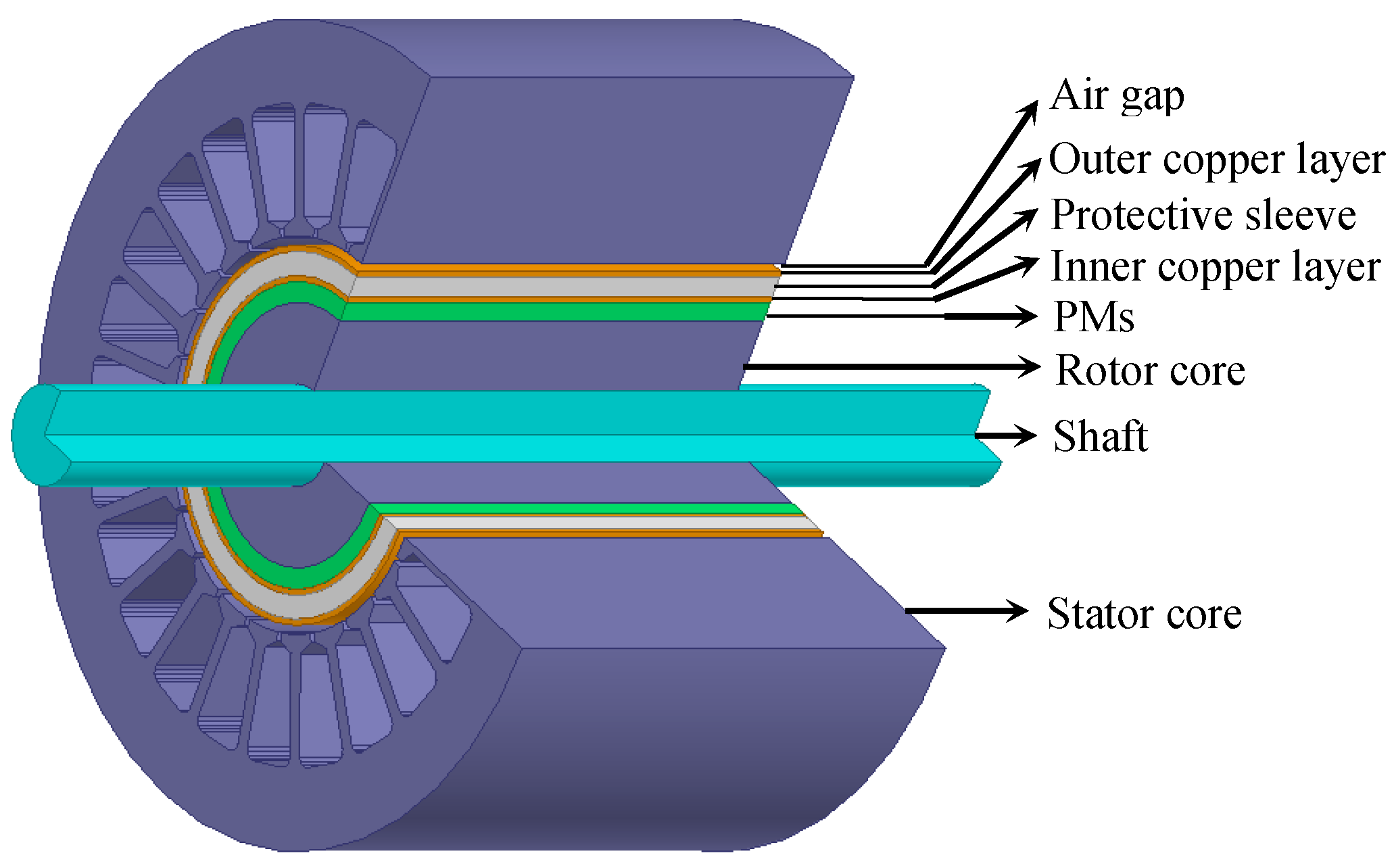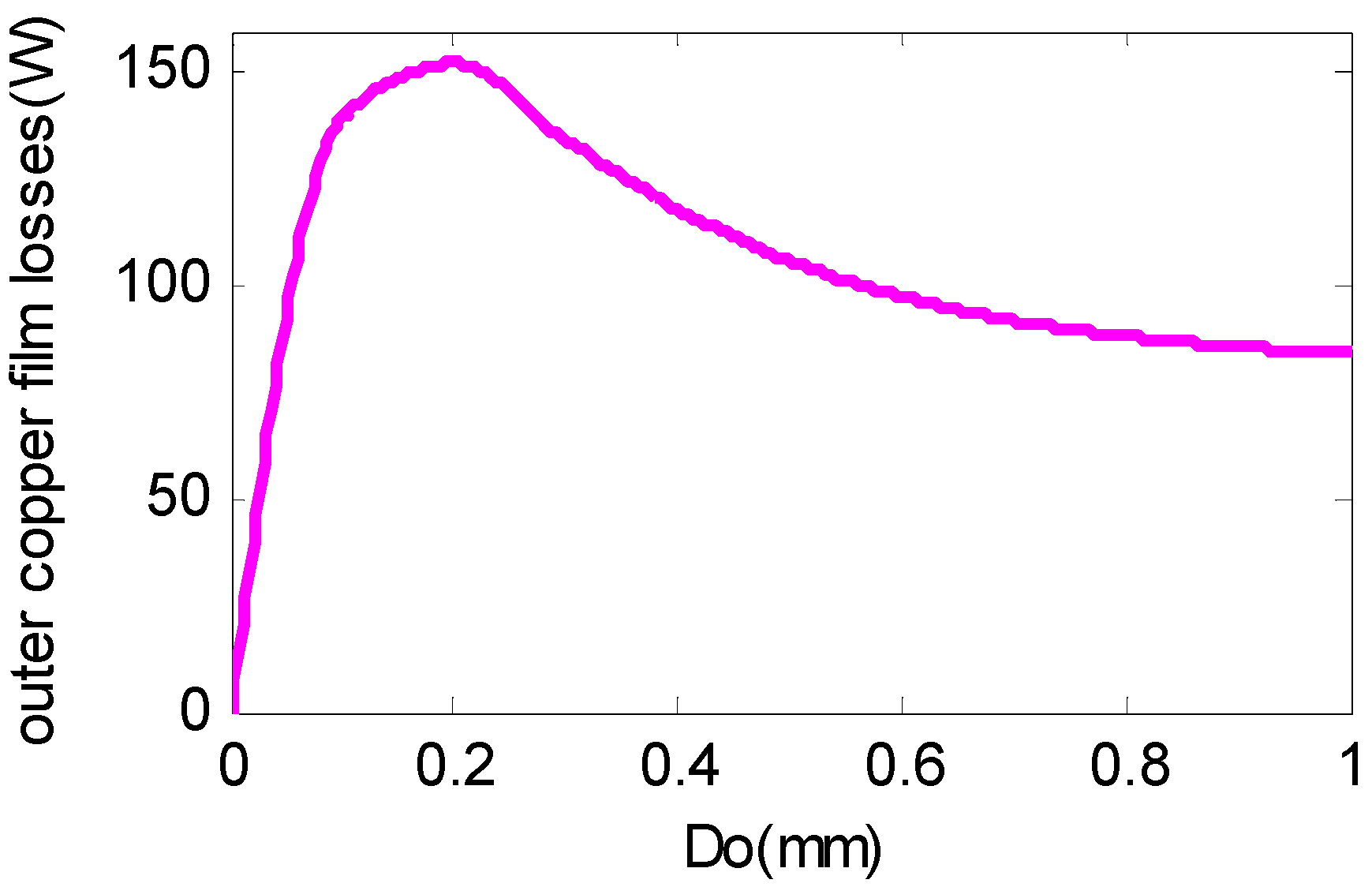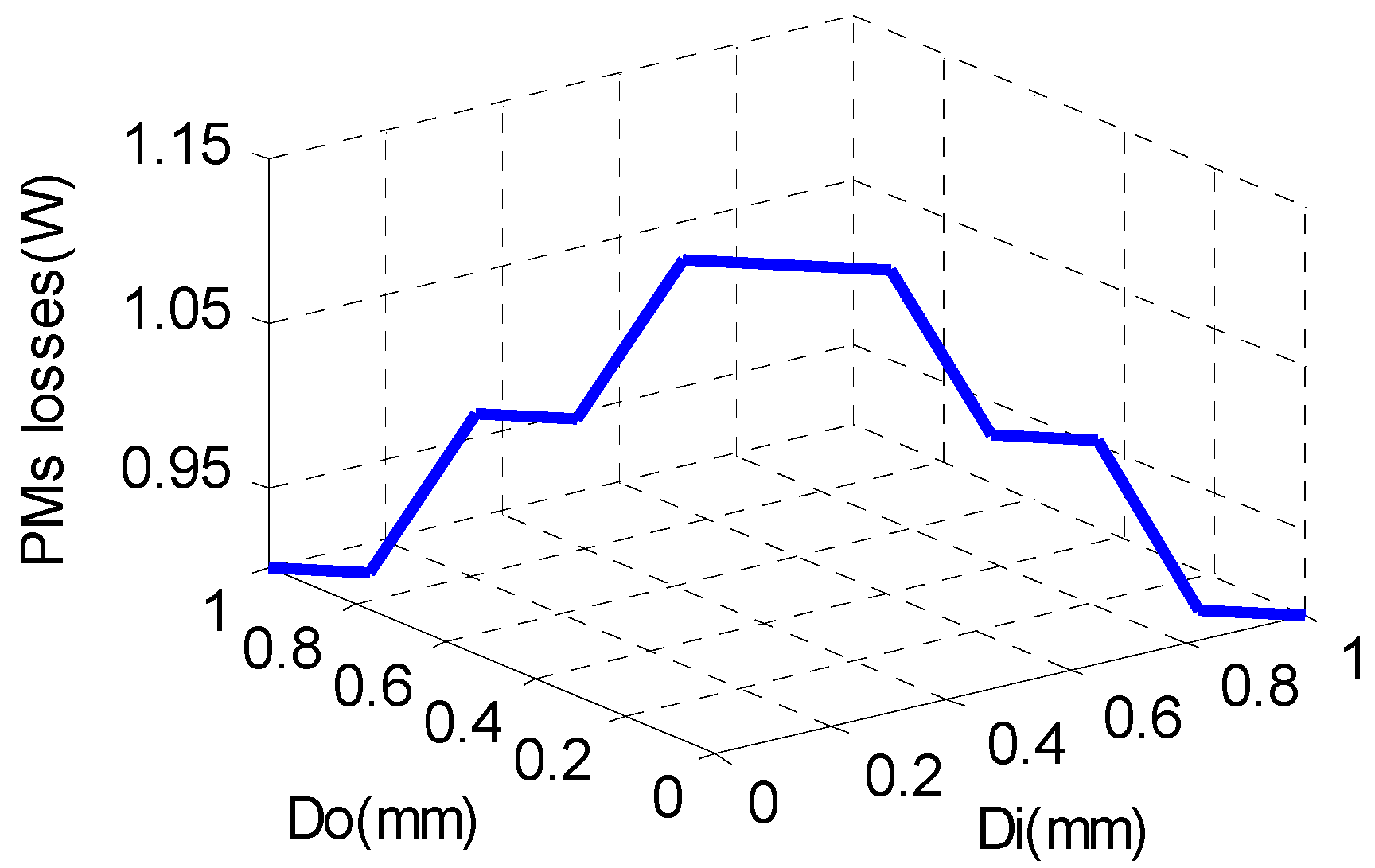Optimal Design of the Rotor Structure of a HSPMSM Based on Analytic Calculation of Eddy Current Losses
Abstract
:1. Introduction
2. Analytic Calculation of Rotor Eddy Current Losses
2.1. Analytic Calculation Model
- (1)
- The stator and rotor are expanded into a planar ferromagnetic body in a half space.
- (2)
- The stator winding current on the surface between the stator and air gap is equivalent to the sinusoidal distribution of surface current.
- (3)
- The magnetic permeability of the stator core is close to infinity and the conductivity is 0.
- (4)
- The harmonics hardly enter the rotor core area, so the eddy current losses of the rotor core are not considered in the calculation of the HSPMSM.
- (5)
- End effect is not considered.
- (6)
- All field quantities are sinusoidal over time.
2.2. Calculation of the Rotor Eddy Losses in HSPMSM
3. The Influence of Rotor Structure Optimization on the Rotor Losses
4. Conclusions
Author Contributions
Conflicts of Interest
References
- Han, S.H.; Jahns, T.M.; Zhu, Z.Q. Analysis of rotor core eddy-current losses in interior Permanent-Magnet Synchronous Machines. IEEE Trans. Ind. Appl. 2010, 46, 196–205. [Google Scholar] [CrossRef]
- Han, S.H.; Jahns, T.M.; Zhu, Z.Q. Analysis of rotor core eddy-current losses in interior permanent magnet synchronous machines. In Proceedings of the 2008 IEEE Industry Applications Society Annual Meeting, Edmonton, AB, Canada, 5–9 October 2008; pp. 1–8. [Google Scholar]
- Deiana, F.; Serpi, A.; Abrahamsson, J.; Marongiu, I.; Gatto, G. Extensive losses estimation of a novel high-speed permanent magnet synchronous machine for flywheel energy storage systems. In Proceedings of the 2016 XXII International Conference on Electrical Machines (ICEM), Lausanne, Switzerland, 4–7 September 2016; pp. 1728–1734. [Google Scholar]
- Wan, Y.; Cui, S.M.; Wu, S.P. Design and temperature rise analysis of a high speed PMSM for pulsed power system. In Proceedings of the 2015 IEEE International Conference on Applied Superconductivity and Electromagnetic Devices (ASEMD), Shanghai, China, 20–23 November 2015; pp. 177–178. [Google Scholar]
- Martin, F.; Belahcen, A.; Zaïm, M.E.H. Effect of magnet materials on optimal design of a high speed PMSM. In Proceedings of the 2015 18th International Conference on Electrical Machines and Systems (ICEMS), Pattaya City, Thailand, 25–28 October 2015; pp. 661–667. [Google Scholar]
- Yulong, P.; Xing, L.; Yi, L.; Feng, C. Effect of air gap eccentricity on rotor eddy current loss in high speed PMSM used in FESS. In Proceedings of the 2014 17th International Symposium on Electromagnetic Launch Technology, San Diego, CA, USA, 7–11 July 2014; pp. 1–6. [Google Scholar]
- Liu, X.; Du, J.; Liang, D. Analysis and speed ripple mitigation of a space vector pulse width modulation-based permanent magnet synchronous motor with a particle swarm optimization algorithm. Energies 2016, 9, 923. [Google Scholar] [CrossRef]
- Chiodetto, N.; Bianchi, N.; Alberti, L. Improved analytical estimation of rotor losses in high-speed PM synchronous machines. In Proceedings of the 2016 XXII International Conference on Electrical Machines (ICEM), Lausanne, Switzerland, 4–7 September 2016; pp. 1788–1794. [Google Scholar]
- Gengji, W.; Ping, W. Rotor loss analysis of PMSM in Flywheel Energy Storage System as Uninterruptable Power Supply. IEEE Trans. Appl. Supercond. 2016, 26, 1–5. [Google Scholar] [CrossRef]
- Wang, G.J.; Wang, P.; Wang, X.Y. Analyze of permanent magnet loss of high speed permanent magnet synchronous motor for flywheel energy storage system. In Proceedings of the 2015 IEEE International Conference on Applied Superconductivity and Electromagnetic Devices (ASEMD), Shanghai, China, 20–23 November 2015; pp. 549–550. [Google Scholar]
- Jardan, R.K.; Varga, Z.; Stumpf, P.; Nagy, I.; Endisch, C.; Sipos, P.; Simon, M. Development of a dedicated laboratory system for measurement of iron losses in high speed PMSM. In Proceedings of the 2015 IEEE International Conference on Industrial Technology (ICIT), Seville, Spain, 17–19 March 2015; pp. 708–713. [Google Scholar]
- Marashi, A.N.; Abbaszadeh, K.; Alam, F.R. Analysis and reduction of magnet eddy current losses in surface mounted permanent magnet machines. In Proceedings of the 2014 22nd Iranian Conference on Electrical Engineering (ICEE), Tehran, Iran, 20–22 May 2014; pp. 782–786. [Google Scholar]
- Lahne, H.C.; Gerling, D.; Staton, D.; Chong, Y.C. Design of a 50,000 rpm high-speed high-power six-phase PMSM for use in aircraft applications. In Proceedings of the 2016 Eleventh International Conference on Ecological Vehicles and Renewable Energies (EVER), Monte Carlo, Monaco, 6–8 April 2016; pp. 1–11. [Google Scholar]
- Gerada, D.; Mebarki, A.; Gerada, C. Optimal design of a high speed concentrated wound PMSM. In Proceedings of the 2009 International Conference on Electrical Machines and Systems, Tokyo, Japan, 15–18 November 2009; pp. 1–6. [Google Scholar]
- Zhao, L.; Chan, H.; Wu, T. A new design approach of an ultra high-speed permanent magnet synchronous motor (PMSM) system. In Proceedings of the INTERMAG 2006—IEEE International Magnetics Conference, San Diego, CA, USA, 8–12 May 2006; p. 306. [Google Scholar]
- Kim, S.I.; Kim, Y.K.; Lee, G.H.; Hong, J.P. A novel rotor configuration and experimental verification of interior PM synchronous motor for high-speed applications. IEEE Trans. Magn. 2012, 48, 843–846. [Google Scholar] [CrossRef]
- Sough, M.; Depernet, D.; Dubas, F.; Boualem, B.; Espanet, C. Analytical model of PMSM designed for high-frequency operation machine and inverter sizing compromise. In Proceedings of the 2011 IEEE Energy Conversion Congress and Exposition, Phoenix, AZ, USA, 17–22 September 2011; pp. 1436–1440. [Google Scholar]
- Zheng, L.; Wu, T.X.; Acharya, D.; Sundaram, K.B.; Vaidya, J.; Zhao, L.; Zhou, L.; Ham, C.H.; Arakere, N.; Kapat, J.; et al. Design of a super-high speed permanent magnet synchronous motor for cryogenic applications. In Proceedings of the IEEE International Conference on Electric Machines and Drives, San Antonio, TX, USA, 15–18 May 2005; pp. 874–881. [Google Scholar]
- Dubas, F.; Rahideh, A. Two-dimensional analytical permanent-magnet eddy-current loss calculations in slotless PMSM equipped with surface-inset magnets. IEEE Trans. Magn. 2014, 50, 54–73. [Google Scholar] [CrossRef]
- Rabiei, A.; Thiringer, T.; Lindberg, J. Maximizing the energy efficiency of a PMSM for vehicular applications using an iron loss accounting optimization based on nonlinear programming. In Proceedings of the 2012 XXth International Conference on Electrical Machines, Marseille, France, 2–5 September 2012; pp. 1001–1007. [Google Scholar]
- Riemer, B.; Leßmann, M.; Hameyer, K. Rotor design of a high-speed permanent magnet synchronous machine rating 100,000 rpm at 10 kW. In Proceedings of the 2010 IEEE Energy Conversion Congress and Exposition, Atlanta, GA, USA, 12–16 September 2010; pp. 3978–3985. [Google Scholar]
- Hongbo, Q.; Ran, Y.; Weili, L.; Nan, J. Influence of rectifiers on high-speed permanent magnet generator electromagnetic and temperature fields in distributed power generation systems. IEEE Trans. Energy Convers. 2015, 30, 655–662. [Google Scholar] [CrossRef]
- Weili, L.; Hongbo, Q.; Xiaochen, Z.; Ran, Y. Influence of copper plating on electromagnetic and temperature fields in a high-speed permanent-magnet generator. IEEE Trans. Magn. 2012, 48, 2247–2253. [Google Scholar] [CrossRef]
- Li, W.; Qiu, H.; Zhang, X.; Cao, J.; Yi, R. Analyses on electromagnetic and temperature fields of superhigh-speed permanent-magnet generator with different sleeve materials. IEEE Trans. Ind. Electron. 2014, 61, 3056–3063. [Google Scholar] [CrossRef]
- Li, W.; Qiu, H.; Zhang, X.; Cao, J.; Zhang, S.; Yi, R. Influence of rotor-sleeve electromagnetic characteristics on high-speed permanent-magnet generator. IEEE Trans. Ind. Electron. 2014, 61, 3030–3037. [Google Scholar] [CrossRef]
- Mlot, A.; Lukaniszyn, M.; Korkosz, M. Influence of an end-winding size on proximity losses in a high-speed PM synchronous motor. In Proceedings of the 2015 Selected Problems of Electrical Engineering and Electronics (WZEE), Kielce, Poland, 17–19 September 2015; pp. 1–6. [Google Scholar]
- Yu, Y.; Liang, D.; Liu, X.; Liang, Z.; Ze, Q. The influence on the rotor loss of the high-speed motor by optimizing the rotor structure. In Proceedings of the 2016 Eleventh International Conference on Ecological Vehicles and Renewable Energies (EVER), Monte Carlo, Monaco, 6–8 April 2016; pp. 1–4. [Google Scholar]
- Yongxiang, X.; Qingbing, Y.; Jibin, Z.; Hao, W. Influence of periodic carrier frequency modulation on stator steel core loss and rotor eddy current loss of permanent magnet synchronous motor. In Proceedings of the 2014 17th International Conference on Electrical Machines and Systems (ICEMS), Hangzhou, China, 22–25 October 2014; pp. 2094–2100. [Google Scholar]
- Nair, S.S.; Wang, J.; Chen, L.; Chin, R.; Manolas, I.; Svechkarenko, D. Computationally efficient 3D rotor eddy current loss prediction in permanent magnet machines. In Proceedings of the 2016 XXII International Conference on Electrical Machines (ICEM), Lausanne, Switzerland, 4–7 September 2016; pp. 1426–1432. [Google Scholar]
- Bernard, N.; Dang, L.; Olivier, J.C.; Bracikowski, N.; Wasselynck, G.; Berthiau, G. Design optimization of high-speed PMSM for electric vehicles. In Proceedings of the 2015 IEEE Vehicle Power and Propulsion Conference (VPPC), Montreal, QC, Canada, 19–22 October 2015; pp. 1–6. [Google Scholar]
- Hemeida, A.; Sergeant, P. Analytical modeling of surface PMSM using a combined solution of Maxwell’s equations and magnetic equivalent circuit. IEEE Trans. Magn. 2014, 50, 1–13. [Google Scholar] [CrossRef]
- Hemeida, A.; Sergeant, P. Analytical modeling of eddy current losses in Axial Flux PMSM using resistance network. In Proceedings of the 2014 International Conference on Electrical Machines (ICEM), Berlin, Germany, 2–5 September 2014; pp. 2688–2694. [Google Scholar]








| Parameter | Value | Parameter | Value |
|---|---|---|---|
| Stator outer diameter | 135 mm | Copper layer thickness | 1 mm |
| Stator inner diameter | 66 mm | Permanent magnet thickness | 3.5 mm |
| Rotor outer diameter | 61 mm | Rated speed | 60,000 rpm |
| Protective sleeve thickness | 4 mm | Rated frequency | 1000 Hz |
| Relative Permeability | Value | Conductivity | Value |
|---|---|---|---|
| μo | 1 | σr | 1,315,789 S/m |
| μr | 1 | σc | 59,000,000 S/m |
| μc | 1 | σp | 1,182,791 S/m |
| μp | 1 | σz | 1,000,000 S/m |
| μz | 7000 | - | - |
| Symbol | Analytic Calculation Results | FEA Results |
|---|---|---|
| Pr | 239.4 W | 260.8 W |
| Pc | 4.1 W | 4.4 W |
| Pp | 0.86 W | 0.9 W |
| Pr+c+p | 244.36 W | 265.2 W |
© 2017 by the authors. Licensee MDPI, Basel, Switzerland. This article is an open access article distributed under the terms and conditions of the Creative Commons Attribution (CC BY) license (http://creativecommons.org/licenses/by/4.0/).
Share and Cite
Yu, Y.; Liang, D.; Liu, X. Optimal Design of the Rotor Structure of a HSPMSM Based on Analytic Calculation of Eddy Current Losses. Energies 2017, 10, 551. https://doi.org/10.3390/en10040551
Yu Y, Liang D, Liu X. Optimal Design of the Rotor Structure of a HSPMSM Based on Analytic Calculation of Eddy Current Losses. Energies. 2017; 10(4):551. https://doi.org/10.3390/en10040551
Chicago/Turabian StyleYu, Yanan, Deliang Liang, and Xing Liu. 2017. "Optimal Design of the Rotor Structure of a HSPMSM Based on Analytic Calculation of Eddy Current Losses" Energies 10, no. 4: 551. https://doi.org/10.3390/en10040551





